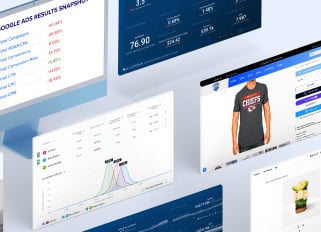
E-commerce Schema: What is it and Why Your Website Needs it
Today, we’re peeling back the layers of a critical yet often overlooked component of e-commerce success—Schema Markup. Specifically, we’re talking about e-commerce schema, the secret sauce that can turbocharge your e-commerce website’s visibility, user engagement, and sales.
But what is it exactly, and why should you care?
Grab your coffee because we’re about to take you on a journey through the intricate world of e-commerce schema.
What is e-commerce Schema?
E-commerce schema is a form of structured data that helps search engines understand the content on your web page. Think of it as a translator that converts your web content into a language that search engines can easily interpret, defining different types of web pages through schemas. By adding specific code to your site, you provide search engines with additional context about your products, reviews and ratings, and business details.
How Does Schema Markup Work?
When you add schema markup to your HTML, it enhances the snippets of information that appear in Google search results. These enhanced snippets are known as “rich snippets” and may include star ratings, product prices, and availability. Essentially, schema markup makes your search results more attractive and informative to potential customers, thereby increasing click-through rates.
Benefits of Implementing E-commerce Schema
Schema markup can significantly enhance your website's visibility on the search engine results page, making your product information more attractive and eye-catching.
You might be wondering why e-commerce schema is such a big deal. Well, here are some compelling reasons:
 Improves SEO Ranking
Improves SEO Ranking
Imagine a search engine crawling your website—it might struggle to interpret crucial details about your products, like prices, ratings, or availability. Schema markup clarifies this, highlighting essential information directly in search engine results.
For example, using product schema can allow Google to display your product’s rating, price, and stock availability as rich snippets in the search results.
Generates Rich Snippets
Rich snippets are powerful attention magnets. By displaying additional details like ratings, prices, and reviews, you can increase the likelihood of users clicking on your product pages.
Boosts Click-Through Rate (CTR)
A detailed and engaging search snippet increases user curiosity and trust, resulting in higher CTRs compared to plain search results.
Enhances User Trust
Schema markup, such as reviews and aggregate ratings, adds social proof to your products, building credibility with your audience and encouraging conversions.
Improves Local SEO
For e-commerce businesses with physical stores, local schema can highlight operating hours, location, and customer reviews, making it easier for nearby prospects to find you.
Understanding E-commerce Schema Types
E-commerce businesses can leverage various schema types to highlight key aspects of their content. Below are the most common types of e-commerce schema:
- Product Schema: Showcase key product details such as name, brand, SKU, and more. It ensures that accurate and relevant information appears in search results, helping potential customers make informed decisions at a glance.
- Article Schema: Display news articles, blogs, or other editorial content in a structured format. This can include information such as article headline, author, and publishing date.
- Offer Schema: Highlight pricing, discounts, and currency with offer schema. Perfect for promoting special deals, it ensures your promotions stand out directly in search results.
- Aggregate Rating Schema: Display star ratings and review counts to immediately build trust with new customers. This schema integrates positive ratings and reviews into search snippets, creating a strong first impression.
- Review Schema: Feature detailed customer feedback through review schema. It adds credibility to your products and helps buyers make confident purchasing decisions.
- Breadcrumb Schema: Improve navigation and clarity for both users and search engines with breadcrumb schema. This is particularly beneficial for large e-commerce sites, ensuring your site’s hierarchy is easily understood.
- FAQ Schema: Address common pre-sales questions directly in search results with FAQ schema. This reduces customer support inquiries while boosting your SEO performance.
How to Implement E-commerce Schema
Manual Implementation
To manually add schema to your website, you’ll need to write JSON-LD, Microdata, or RDFa code and embed it into your product pages.
- Use Google’s Structured Data Markup Helper for guidance.
- Test your code using the Google Rich Results Test tool to ensure accuracy.
While manual implementation offers precise control, it requires a basic understanding of coding.
Using Plugins or Tools
For non-technical users, plugins and tools simplify schema implementation. Popular options include:
- Schema Pro and Yoast SEO Premium for WordPress.
- JSON-LD Generator for quick schema code.
- Shopify and Magento also offer extensions for schema integration.
Selecting the right tool depends on your platform and your familiarity with editing code.
 Best Practices and Common Mistakes
Best Practices and Common Mistakes
When implementing e-commerce schema, follow these best practices to maximize efficiency and impact:
Be Specific and Accurate
Ensure all structured data reflects accurate information about your products, such as price and stock levels. Incorrect data can lead to penalties.
Use Relevant Schema Types
Even seasoned SEO experts can make mistakes when implementing schema markup. One common mistake is not using the correct schema types, such as failing to implement a local business schema for physical stores. To avoid errors, focus on schema types most applicable to your e-commerce store.
Update Regularly
Schema data should be updated as your product or shipping information changes. For example, if you run out of stock, ensure this is reflected in your schema.
 Avoid Keyword Stuffing
Avoid Keyword Stuffing
It’s tempting to pack product descriptions in schema with keywords, but this can harm your SEO efforts. Instead, focus on clarity and accuracy.
Test Before Launch
Always test your schema markup with Google’s tools to ensure it is properly implemented and does not create crawl errors.
Measuring the Impact of E-commerce Schema
Once your schema markup is applied, it is essential to measure its impact. Google Search Console is an excellent tool for monitoring the performance of your structured data.
Steps to Measure Impact:
- Navigate to the Enhancements Tab: This section displays any schema markup data Google detects on your site.
- Review Error Reports: Check for warnings or implementation errors and correct these as needed.
- Track CTRs and Impressions: Compare the performance metrics for pages with and without schema markup to evaluate any improvements.
By tracking these metrics, you’ll gain insights into the effectiveness of your schema and the adjustments needed for optimization.
The Future of E-commerce Schema
The digital landscape is continually evolving, and so is the role of schema markup in e-commerce. Here’s what the future might hold:
AI Integration
Artificial Intelligence (AI) is becoming increasingly important in SEO. Future advancements could see schema markup being automatically generated and optimized by AI, making the process even more efficient.
Voice Search Optimization
With the rise of voice-activated devices, optimizing for voice search is becoming crucial. Schema markup can help by providing the structured data that voice assistants rely on to deliver accurate and relevant responses.
Enhanced Personalization
Future schema updates might allow for even more personalized search results. Imagine search snippets tailored to individual users based on their previous interactions and preferences.
 Maximizing the Benefits of E-commerce Schema with Bluetuskr
Maximizing the Benefits of E-commerce Schema with Bluetuskr
Ready to take your e-commerce business to the next level? At Bluetuskr, we specialize in helping businesses like yours implement effective website optimization strategies, including e-commerce schema. Our team of experts will work with you to ensure that your e-commerce website is optimized for search engines and provides an exceptional user experience.
Don’t miss out on the opportunity to drive more traffic, enhance user engagement, and boost your sales. Visit Bluetuskr today to learn how we can help you harness the power of e-commerce schema and achieve your business goals.
FAQs
What is the difference between JSON-LD and Microdata format for schema markup?
JSON-LD is a JavaScript-based method of adding structured data to a webpage, while Microdata is an HTML-based approach. Both formats are supported by search engines, but JSON-LD is considered more efficient and easier to implement.
Can I add multiple types of schema to a single webpage?
Yes, you can add multiple types of schema to a single webpage as long as they all accurately represent the content on that page. However, it’s essential not to overload with too many types of schema, as this can negatively affect user experience.
Is it necessary to update my schema markup regularly?
Yes, it’s crucial to stay updated with the latest schema guidelines and update your markup accordingly. This ensures that your website remains compliant and effective in driving traffic and conversions. So, it is necessary to regularly review and update your schema markup as needed.
What is product schema markup?
Product schema markup is a type of structured data that provides detailed information about a specific product. It includes details such as the product name, description, price, availability, and more. This helps search engines understand and display product information in search results, making it easier for potential customers to find your products online.
Can I use an e-commerce schema for my non-e-commerce website?
Yes, you can use some types of e-commerce schema for non-e-commerce websites. For example, breadcrumb schema can be useful for any type of website that has a hierarchical structure, not just e-commerce sites.
However, other types, such as product or offer schema, would not be relevant for non-e-commerce sites. It's important to carefully choose the appropriate schema types for your specific website and content.
How does schema markup benefit my e-commerce business?
Schema markup provides various benefits to e-commerce businesses, including improved visibility in search results, enhanced user experience, and higher click-through rates. It also helps search engines understand the context of your products and better match them with relevant queries, ultimately driving more targeted traffic to your website.
Additionally, using schema markup can give you an edge over competitors who are not utilizing it. So, implementing proper schema markup on your e-commerce site can greatly benefit your business in multiple ways.
Conclusion
E-commerce schema isn’t just a trend—it’s the future of SEO. Businesses that adopt structured data now will stay a step ahead, as search engines increasingly prioritize user experience and relevance.
Implementing e-commerce schema, such as product and review markup, goes beyond boosting your rankings. It enhances the user experience by providing clear, engaging, and informative content directly in search results.
The best part? You don’t have to navigate this alone. Bluetuskr is here to guide you every step of the way.
Ready to elevate your SEO strategy? Explore our e-commerce SEO services or learn more about Bluetuskr, your dedicated e-commerce marketing agency.
Connect With Us
Recent Post

.png)





Tell us what you think!